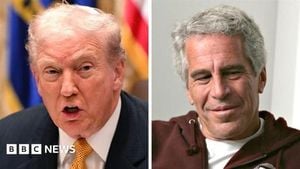Chicago’s Humboldt Park neighborhood has become the latest flashpoint in the national debate over immigration enforcement after a dramatic incident involving an elected city official, federal agents, and a community on edge. On October 3, 2025, Alderperson Jessie Fuentes was handcuffed and briefly detained by federal immigration agents inside Humboldt Park Hospital after she questioned their legal authority to hold a seriously injured man in custody. The incident, caught on video and rapidly circulated online, has stoked controversy, galvanized community leaders, and raised urgent questions about due process and the use of force in immigration operations.
According to multiple reports, including coverage by WGN-TV and Block Club Chicago, Fuentes was alerted that a man—described as roughly 37 years old—had been taken to Humboldt Park Hospital by Immigration and Customs Enforcement (ICE) agents. The man had suffered a broken leg, reportedly while fleeing ICE during a neighborhood operation. When Fuentes arrived at the hospital, she found federal agents stationed outside the emergency room, refusing to allow the injured man access to legal counsel. “People deserve to get medical attention and not fear that they’re going to get detained or deported,” Fuentes told reporters at a press conference. “And so, I arrived at the emergency room, in which the ICE agents were sitting in the room with the individual outside of that room. I asked the ICE agents if they had a judicial warrant for the individual that they were detaining. They refused to answer.”
Video footage from the scene, shared widely on social media and reported by The New Republic, shows Fuentes repeatedly inquiring about the existence of a signed judicial warrant and emphasizing the man’s constitutional rights. One agent, according to the video, replied bluntly, “No. No.” Tensions quickly escalated. When Fuentes pressed further, the agents threatened her with arrest for impeding their operations. “You are going to be placed under arrest—” one masked agent began, before his partner forcibly yanked Fuentes’s arm, turned her around, and placed her in handcuffs. A bystander filming the encounter exclaimed, “This is an alderperson who is being [placed] under arrest!”
Fuentes, visibly distressed, continued to assert that she had not touched the agents and was merely exercising her right to inquire about the legality of their actions. “That man has constitutional rights,” she repeated, even as the agents led her toward the exit. The masked agent eventually told her he did not need a warrant. Outside, Border Patrol agents were preparing to put Fuentes into a vehicle, but she was released from the handcuffs after asking, “What law did I break, outside of exercising my constitutional right to ask if they had a signed judicial warrant?” As reported by Block Club Chicago, she was warned she would be arrested if she reentered the building.
This confrontation did not occur in a vacuum. It unfolded against the backdrop of a sharp uptick in federal immigration enforcement throughout Chicago, particularly since October 2, 2025. The Department of Homeland Security (DHS) announced that over 900 arrests have been made in Illinois as part of “Operation Midway Blitz,” a campaign that has included high-profile raids in neighborhoods with large immigrant populations, such as South Shore, Back of the Yards, and downtown, as reported by Raw Story and Emegypt. In Humboldt Park itself, an early morning raid saw a Venezuelan immigrant’s home forcibly entered, resulting in the detention of her husband and two others by ICE agents.
Community leaders and advocacy groups have responded with outrage and calls for accountability. On the day of the hospital incident, Fuentes was joined by State Senator Graciela Guzmán, Cook County Commissioner Jessica Vásquez, Alderman Anthony Quezada, and Alderwoman Rossana Rodríguez-Sánchez outside Humboldt Park Health’s emergency room. They condemned what they described as “ongoing militarized immigration enforcement” and demanded that ICE allow an immigration attorney to speak with the detained man. The Illinois Coalition for Immigrant and Refugee Rights also participated in the demonstration, denouncing what they see as aggressive and unjust tactics by federal authorities.
Reports of law enforcement tactics have only fueled community anger. Fuentes and others described the use of tear gas and pepper spray by federal agents near local businesses, including Rico Fresh on Armitage and Central Park Avenue. “One of the first calls I responded to was ICE throwing tear gas right outside Rico Fresh on Armitage and Central Park, pepper-spraying customers coming out of the grocery store, rapid responders, people driving by who had to pull over because they could no longer see,” Fuentes recounted, as cited by WGN-TV. Video evidence from Logan Square showed an agent allegedly throwing a gas canister out of an SUV window during a traffic jam, further escalating tensions.
ICE, for its part, has defended its actions. In a statement provided to WGN-TV, the agency said, “During a targeted immigration enforcement operation in Chicago, U.S. Border Patrol vehicles were impeded by protesters. After repeated vocal attempts to disperse the crowd, USBP deployed tear gas and pepper balls. During this operation an illegal alien was arrested and later complained of a leg injury after attempting to flee law enforcement. Out of an abundance of caution he was taken to the hospital for medical treatment. At the hospital, nearly 30 protesters, attempted to break into where the detainee was receiving medical care. Our brave officers are facing a surge in increase in assaults against them, inducing sniper attacks, cars being used as weapons on them, and assaults by rioters. This violence against law enforcement must END. We will not be deterred by rioters and protesters in keeping America safe.”
Fuentes, however, remains unconvinced and deeply critical of federal tactics. “What ICE is doing is exercising violence,” she said at the press conference. “Physical violence on the people of Chicago.” She further alleged that this was not an isolated event but rather “common practice,” with ICE agents routinely detaining individuals in hospital emergency rooms after injuries sustained during enforcement actions. “ICE has been taking individuals into hospital rooms, into emergency rooms, because people are harmed while ICE is trying to detain people in the city of Chicago.”
The incident has drawn national attention, with civil rights advocates warning that the aggressive approach risks undermining trust between immigrant communities and public institutions, especially hospitals. Legal experts have also weighed in, noting that while ICE agents have broad powers in enforcing immigration law, the question of access to legal counsel and the requirement for judicial warrants in certain settings remains hotly contested.
Meanwhile, Chicago’s immigrant communities continue to grapple with the reality of stepped-up enforcement. Residents and local leaders are working with legal representatives and advocacy groups to monitor ongoing raids and support those affected. The city’s response, both official and grassroots, will likely shape the broader debate over immigration policy and civil liberties in the months ahead.
As the dust settles from the chaotic events at Humboldt Park Hospital, one thing is clear: the struggle over immigration enforcement in Chicago is far from over, and the questions raised by Alderperson Fuentes’s confrontation with federal agents are unlikely to fade from the public consciousness anytime soon.




